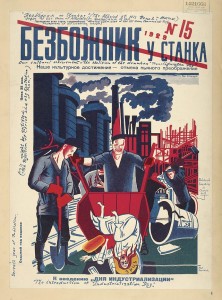How Violent Was the Past?
The Violence of the Churches
The Sins of the Crusaders
Christians, Nazis and Communists
How Safe Has Science Made the World?
In the second chapter of New Atheism: A Survival Guide I argue that:
Scientific progress could face severe practical obstacles. Science cannot rewrite human nature. While it might enhance human capabilities one day, humans will still act in whatever way seems best to them…The very power that scientific progress has brought to society makes that society vulnerable. We can now devour resources and destroy life at unprecedented rates. Simply reflect on the power that scientific progress put in the hands of a Soviet nuclear submarine commander during the Cuban missile crisis. If we ignore the anarchy that reigns in the human heart, the very power of scientific discovery could bring scientific progress to a terrible end.
To some extent, I am critiquing secularism’s “Myth of Progress.” This teaches that, just as science has grown in knowledge, and just as technology has become more and more advanced, society is also becoming more enlightened, moving in a definite, desirable direction. The advance of science seems to be correlated with the withdrawal of religion. Therefore, as progress marches on religion and tradition will retreat, and reason will triumph over superstition. But is this myth truly mythological? After all, it has been defended with a blistering storm of graphs and charts in Steven Pinker’s The Better Angels of Our Nature.
Pinker complains that “[t]he loathing of modernity is one of the great constants of contemporary social criticism”, but “unsentimental history and statistical literacy can change our view of modernity (Pinker, p.692-3)”. According to Pinker, we have moved away from “tribalism, authority, and purity in moral systems” and toward “humanism, classical liberalism, autonomy and human rights” (p.691). This is a “kind of Whig history which is supported by the facts” (p.692). Unfortunately, Pinker’s account of the historical facts does not inspire confidence. The reader gets the strong impression that he has uncritically accepted any claim which supports the thesis that humanity is becoming less violent.
Now, many of Pinker’s arguments are completely unobjectionable. Education, exploration, medicine, science and law are all beneficial. Everyone agrees that vaccination programs have been good for us and that police forces tend to drive crime down. Everyone agrees that we should welcome aspects of modernity; but Pinker consistently overlooks the contributions of tradition and religion to civilization. For example, he fails to appreciate the role of Christian theology for the birth of human rights and the scientific revolution; he underestimates the importance of monogamous marriage to the civilising process[i].
Pinker’s central argument is that human beings have become less violent over time. It is true that the absolute number of humans killed in war has risen over time. However, this is because the world population has increased exponentially; Pinker contends that the percentage of the world population killed by conflict has actually fallen. Measuring violence as a “killing rate” relative to the total world population seems like a reasonable way to proceed. So, at the heart of Pinker’s case is a table, a “worst things list”, which sorts the killing rates of the worst wars and atrocities as a percentage of the extant human population (p.197). According to this analysis, the 20th Century was not the worst, and the most terrible violence occurred in the distant past.
David Bentley Hart’s (2012) warning seems apposite:
Population sample sizes can vary by billions, but a single life remains a static sum, so the smaller the sample the larger the percentage each life represents. Obviously, though, a remote Inuit village of one hundred souls where someone gets killed in a fistfight is not twice as violent as a nation of 200 million that exterminates one million of its citizens.
Robert Epstein notes
… the assumption on which Pinker’s entire case rests: that we look at relative numbers instead of absolute numbers in assessing human violence. But why should we be content with only a relative decrease? By this logic, when we reach a world population of nine billion in 2050, Pinker will conceivably be satisfied if a mere two million people are killed in war that year.
Craig S. Lerner (2012) also worries that Pinker’s table: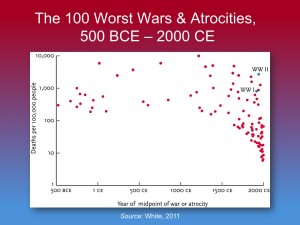
…stacks the deck in his favor. The multiple wars of the 20th century are disaggregated, with the result that none scores notably high after adjusting for global population. By contrast, the “Mideast Slave Trade,” with a reported 19 million dead, wins the bronze medal as third most deadly event in human history. It spanned 12 centuries, however, from 700 to 1900 A.D. Historians a millennium from now, if they exist, will likely collect several wars of the last century (World War I, the Russian Civil War, World War II, etc.), as a single event. So aggregated, the “Germanic Wars of the Twentieth Century” emerge, even on a converted basis, as one of the deadliest conflicts in history.
Put these concerns to one side; the greatest problem with Pinker’s model is that his data is very unreliable. Anthropologist R. Brian Fergusson has robustly challenged Pinker’s claim that primitive, “stateless” societies are extraordinarily violent. The archaeological evidence that Pinker assembles to make this claim “… consists of cherry-picked cases with high casualties, clearly unrepresentative of prehistory in general”(Fergusson, 2013, p.116); and a “…selective compilation of highly unusual cases, grossly distorting war’s antiquity and lethality (ibid. p.126).” To be clear, Fergusson does not accept Rosseau’s myth of the noble savage. Primitive hunter-gatherers knew murder and violence, but they could not sustain the populations necessary for sustained warfare. Furthermore, they had access to more than enough food to support their small populations, so there was little need to compete for territory and resources.
So much for pre-history; Pinker fares little better when extracting data from the historical record. Estimating death tolls is not easy: simply consider the controversy over the number of casualties in Afghanistan, or the two wars in Iraq. Unfortunately, Pinker naively follows the ‘analysis’ of Matthew White (a librarian and self-proclaimed “atrocitologist”) who, cavalierly dismisses the idea that historical records might exaggerate or overestimate body counts (p.197) as a prejudice of modern historians. No sources are analysed, no argument is made, to support such a contentious and controversial conclusion; White just says so, and Pinker needs his say-so to establish that violence has been decreasing. Who needs von Ranke, who cares about careful source analysis, when the numbers fit your model?
Pinker and White claim that the An Lushan revolt in Mediaeval China wiped out 36 million souls. This would mean that the revolt “resulted in the loss of two-thirds of the empire’s population, a sixth of the world’s population at the time” making the An Lushan rebellion “the worst atrocity of all time”(p.194). This claim is as absurd as it sounds. An Lushan was a garrison which rebelled against the Tang dynasty in 755. Pinker and White point out that the census taken in the year 753 recorded a population of nearly 53 million; in 764 the census recorded roughly 17 million. The missing millions are supposedly casualties of war[ii].
However, historians believe the Tang court was unable to carry out effective censuses during and after the revolt; the 764 census findings were smaller than the census in 753 simply because many homes went unregistered. The Chinese population remained healthy in the Eighth and Ninth Centuries; this would not have been the case if it had lost two thirds of its population in an eight year rebellion! An Lushan was a tragedy, but it is not at all clear that it was the apocalypse of Pinker’s imagination (Clarke, 2011).
We should also be extremely dubious of Pinker’s claim that 7 million people were casualties of the Thirty Years War between 1618 and 1648. In Europe’s Tragedy Peter H. Wilson puts the figure at 5 million (p.787); he also reminds us that it is a “myth” that the war was a period of “all destructive fury” (p. 779). Now of course five million is a very high death toll, perhaps 20% of Europe’s population at the time. However, only 10% of the casualties of the Thirty Years war were killed in the fighting. Although troop movements made things far worse… “[d]isease proved more potent than muskets, sword and cannon” (p.790).
…these figures need to be placed into their contemporary context, where high mortality was the norm. Augsburg recorded 38,00 plague victims in eight years in the first half of the sixteenth century, followed by 20, 000 in seven years between 1550 and 1600, compared to the 34,000 lost in the nine years of epidemics in 1600-50. London lost a fifth of its population in each of its outbreaks in 1595, 1603 and 1625, and had only eleven years without high mortality rates between 1625 and 1646. It is thus very likely that many of the people who died in the Empire between 1618 and 1648 would have had their lives cut short even without the war. The 1622 epidemic reached Augsburg not through soldiers but commerce with Amsterdam, for instance… (Wilson, p.793).
Pinker attempts to re-create the Crusaders as mediaeval Nazi’s when he reports that:
Crusader armies were mobilised to fight a “just war” to retake Jerusalem form Muslim Turks, earning them remission of sins and a ticket to heaven. They massacred Jewish communities on the way, and after besieging and sacking Nicea, Antioch, Jerusalem and Constantinople, they slaughtered their Muslim and Jewish populations. Rummel estimates the death toll at 1 million. The world had around 400 million people at the time, about a sixth of the number in the mid-20th century, so the death toll of the Crusader massacres as a proportion of the world’s population would today come out at around 6 million, equivalent to the Nazi’s genocide of the Jews (2011, 140).
There are several problems here, none of them minor. Set aside the fact that Pope Urban II had to abandon just war theory to defend his vision of a Holy War. In the above passage, Pinker conflates the “People’s Crusade” led by Peter the Hermit, the First Crusade and the Fourth Crusade. This gives the impression that the First Crusade was a murderous, bloodthirsty hoard bent on nothing short of genocide. We need not approve of the means and ends of the Crusaders to point out that this is little more than a caricature. The Crusaders were brutal, and often callous, warriors – so were their opponents and allies – but they were not 11th Century Nazis.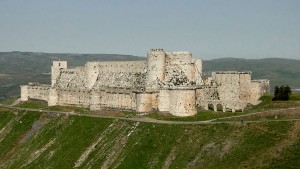
By comparing the Crusaders to Nazi’s, Pinker gives the impression that the death toll of the crusades was made up entirely of the Crusader’s victims. In fact, Crusading was extremely hazardous to one’s health. As many as a third of the aristocrats who set out on Crusade, and 80% of their followers, never returned (Tyerman,2004, p.103). It remains very difficult to give a good estimate of deaths caused in battle, however, because logistical difficulties caused many deaths through starvation; civilians tended to flee from cities and towns in the paths of the opposing armies; and armies on both sides suffered from high rates of desertion.
Pinker’s estimate of 1 million dead is based on a figure given by the political scientist RJ Rummel; Rummel’s methodology is not explained. In any case, this estimate seems exaggerated and unsound. In his acclaimed history The Crusades Thomas Asbridge explains the difficulties historians have estimating the numbers involved in the Crusades “primarily because of the unreliability of wildly inflated contemporary estimates” (2010, p.42).
Consider the fall of Jerusalem to the first Crusade in 1099. Asbridge acknowledges that the historical sources force us to “…acknowledge the terrible inhumanity of the Crusader’s sadistic butchery” (2010, p.102). However, he also sounds a note of caution. Both Crusaders and Muslims sought to exaggerate the extent of the slaughter: Muslims to portray the Crusaders as barbarians, the Crusaders to consolidate their image as God’s avenging warriors. Muslim sources put the number of dead at 70 000; Latin sources estimated 10 000. However,
..recent research has uncovered close contemporary Hebrew testimony which indicates that casualties may not have exceeded 3000, and that large numbers of prisoners were taken when Jerusalem fell. This suggests that, even in the Middle Ages, the image of the crusaders brutality in 1099 was subject to hyperbole and manipulation on both sides of the divide (Asbridge, 2010, p. 102).
Friend and foe alike had good reason to exaggerate the extent of the slaughter in Jerusalem. When Raymond of Aguilers wrote “that in the Temple of Solomon and the portico crusaders rode in blood to the knees and bridles of their horses” he was using the language of the book of Revelation to justify the crusade (Madden, 2004, p.47). His account is hyperbolic and it would be foolish to use it to reconstruct the extent of the massacre.
Pinker’s inaccurate and clichéd account of the Crusades is merely one example of his poor historical judgment. Numerous primary sources are quoted in Better Angels, but few are placed in their historical context, and all are interpreted naively. If William Bradford, one of the Mayflower pilgrims, reported that the natives of Massachusetts flayed, dismembered and then ate other human beings, well it must be true (p.44). If an escaped 19th century convict reports that Australian aborigines became “mad with excitement” when mutilating the bodies of fallen foes (p.45), by golly it must have happened. Drawings from a single 15th Century handbook tell us all we need to know daily life in the Middle Ages (p.66). We do not need to consider reliability, genre or authorial intent because the images confirm Pinker’s biases.
The overall historical trend is not of violence gradually decreasing as the forces of progress push us away from a Hobbesian war against all. Indeed, it is difficult to discern any overall trend in history. Pre-state societies were relatively peaceful until they developed agriculture; a long period of bloody and intense competition for resources followed; then society became relatively more stable as warrior classes emerged (Pearse, 2007, pp.112-119). All we can say with any certainty is that some centuries are more violent than others; and, Pinker’s protestations to the contrary, the atrocities of the 20th Century are the bloodiest on record.
Christians, Nazis and Communists
Pinker’s attack on tradition takes the form of a pincer movement. On one flank, he insists that the Crusaders were the Nazis of their day; on the other flank, he argues that Stalinism and Hitlerism were not the products of modernity, but of religiosity:
Defenders of religion claim that the two genocidal ideologies of the Twentieth Century, fascism and communism, were atheistic. But the first claim is mistaken and the second irrelevant. Fascism happily co-existed with Catholicism in Spain, Italy, Portugal and Croatia. And though Hitler had little use for Christianity, he was by no means an atheist, and professed that he was carrying out a divine plan. (p.677)”
This doesn’t exactly grasp the relevant complexities. Totalitarianism was sold by both communists and fascists as a modern solution to modern problems. Historians find the term “fascism” to be somewhat vague, and tend to treat Nazism separately from fascism in any case. Both communists and Nazis used pseudo-religious propaganda; but they were totalitarians, and could not permit authority to exist outside the state. Therefore, traditional religions had either to be eliminated or controlled. Some Nazis preferred the latter option, adopting and manipulating the Churches as was convenient; but that is a far cry from ‘happy co-existence’.
The Nazi Party did promote something which it called “Positive Christianity” – which effectively became Christianity stripped of 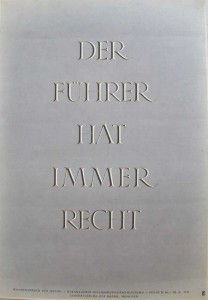 anything which reminded the Nazis of Judaism. Its proponents were forced to preach that Jesus was a Galilean and that Galileans were not Jewish! John Conway at the University of British Columbia clarifies:
anything which reminded the Nazis of Judaism. Its proponents were forced to preach that Jesus was a Galilean and that Galileans were not Jewish! John Conway at the University of British Columbia clarifies:
Nazi Christianity was eviscerated of all the most essential orthodox dogmas. What remained was the vaguest impression combined with anti-Jewish prejudice. Only a few radicals on the extreme wing of liberal Protestantism would recognize such a mish-mash as true Christianity.” (Conway, 2004)
It is also clear that the only Nazi whose opinions mattered –Adolf Hitler- loathed Christianity. It is true that Hitler made political deals with the Catholic Church; yet he also struck a deal with Communist Russia in 1939, and Hitler did not plan to co-exist with Stalin. Hitler was a Machiavellian politician, prepared to do a deal with whoever he wanted, whenever he wanted, so that he could betray them all at his leisure. Michael Burleigh summarises Hitler’s position neatly in his award-winning The Third Reich: A New History
National Socialism, like other totalitarian dictatorships, parodied many of the eschatological and liturgical attributes of redemptive religions, while being fundamentally antagonistic towards the Churches: rivals, as the Nazis saw it, in the subtle, totalising control of minds. However, the overwhelmingly Christian character of the German people meant that Hitler dissembled his personal views behind preachy invocations of the Almighty, and distanced himself from the radically irreligious in his own Party, even though his own views were probably more extreme.” (2001, p.717)
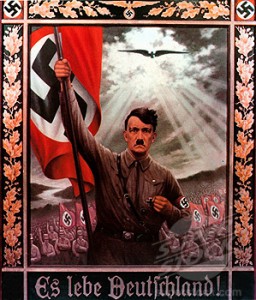 So Pinker’s assertion that Hitler ‘had no use for Christianity’ understates the Fuhrer’s opposition, almost to the point of dishonesty. Hitler believed that Christianity was “whole-hearted Bolshevism under a tinsel of metaphysics” and “an invention of sick brains” (Burleigh, p.718). His hostility to Christianity led to sudden radical outbursts: in early 1937 he declared that “Christianity was ripe for destruction”, and that “the Churches must yield to the primacy of the State” (Kershaw, 2008, p.382). Goebbels took notes of a speech which Hitler gave in December 1941:
So Pinker’s assertion that Hitler ‘had no use for Christianity’ understates the Fuhrer’s opposition, almost to the point of dishonesty. Hitler believed that Christianity was “whole-hearted Bolshevism under a tinsel of metaphysics” and “an invention of sick brains” (Burleigh, p.718). His hostility to Christianity led to sudden radical outbursts: in early 1937 he declared that “Christianity was ripe for destruction”, and that “the Churches must yield to the primacy of the State” (Kershaw, 2008, p.382). Goebbels took notes of a speech which Hitler gave in December 1941:
There would, he made clear, be no place in this utopia for the Christian Churches. For the time being, he ordered slow progression in the ‘Church Question’. But it is clear…that after the war it has to be generally solved…There is, namely, an insoluble opposition between the Christian and a Germanic-heroic world-view.” (Kershaw, 2008, p.382).
Pinker’s analysis of Nazism is also distorted by his naïve insistence that Hitler was the necessary and sufficient cause of both World War Two and the Holocaust[iii]. Whatever Pinker’s assertions (and cherry picked quotes ) it is wrong to claim that there is a consensus among historians on this point. To state the blindingly obvious, we need to explain why the German army and the majority of German civilians supported Hitler’s expansionist aims; and why Britain and France were willing to oppose German expansion with armed force in 1939 but not earlier (Bell, 2007; Overy & Wheatcroft 2009).
As for the Holocaust, Pinker would do well to follow the guidance of Peter Longerich:
The widespread view that this process resulted from a single order from Hitler does not do justice to its complexity. There was in fact a consensus with the leadership of the regime, and also among numerous party functionaries in the occupied territories, that the ‘Jewish question’ should be solved in a murderous fashion. But the realisation of this aim occurred through the interplay of guidelines from above and initiatives from below that was characteristic of the regime (Longerich, 2012, p. 541)
A key player in producing guidelines from above and encouraging initiatives from below was Heinrich Himmler, the leader of the SS, a figure who cannot be ignored because of “the central role that the SS and its leadership played in the German state’s attempt to exterminate the Jewish population of Europe and enslave many other people who found themselves under German control” (Weale, 2010, p.1)
Himmler had a vague belief in a God whom he described as the Teuton “The Ancient.” However, like Rosenberg, Bormann and Goebbels, he had a profound hatred of Christianity. He believed that a belief in the sanctity of life, Christian mercy and Christian sexual morality held back the rise of the German people (Longerich, 2012, p.265); he also rejected Christian accounts of the afterlife for belief in reincarnation (Longerich, 2012 p.269). In Longerich’s assessment:
There is no doubt about Himmler’s anti-communism and anti-Semitism, and he sought to destroy both groups without mercy. Yet he was basically much more interested in Christianity: the conflict with the Christian world in which he had grown up had truly existential significance for him, and by linking opposition to Christians with the idea of restoring the lost Germanic world he had set himself the overriding challenge of his life….By linking de-Christianisation with re-Germanisation, Himmler had provided the SS with a goal and a purpose all of its own (2012, p.265-26)
Pinker acknowledges that Communism was “godless” but blames its excesses on its utopianism; then he blames its utopianism on “the worst idea in the Christian Bible, a millennial cataclysm that will bring about a utopia and restore prelapsarian innocence” (p.677). So are we to believe that the link between atheism and the “League of the Militant Godless” is merely accidental? That Christian eschatology caused militant atheists to burn down Christian churches? The “worst idea in the Christian Bible” is mentioned in only one text, Revelation 20. Christians have interpreted it in a variety of ways, not all of them literally. Neither the Early Church nor 19th Century Evangelicals believed that the doctrine necessitated quietism or revolution. Indeed, the doctrine inspired some of the greatest humanitarian movements in history. The idea that Christian eschatology is even indirectly responsible for the Gulags is ridiculous.
Consider the great 19th Century reformer Anthony Ashley Cooper, the Earl of Shaftesbury. “Faithful an obedient discipleship in the period before the return of Christ lay at the root of Shaftesbury’s work. It was this which motivated his labour as legislator, missionary activist and supporter of voluntary societies” (Turnbull, 2010, p.222). What Pinker often calls progress, Christians call healing – steps back in the direction of Eden. Periods of constructive peace cannot last forever, but they can be achieved. The Christian duty to love our neighbour demands that we seek a better world; the Christian faith in providence gives us hope and strength to build one.
How Safe Has Science Made the World?
It is true that a “Long Peace” has followed the Second World War; since 1945 no two major powers have met on the battle field. We might assume that this is because they would not dare to: the threat of nuclear war makes the cost unbearably high. Pinker disagrees; “the threat of nuclear annihilation deserves little credit for the Long Peace” (p. 268). He points out that small states (North Korea, Afghanistan, Vietnam) were not deterred from challenging nuclear powers. He also believes nuclear weapons were never used because here was a moral “taboo” against using them; it was not fear of escalation that prevented their use, but a moral sense that the horrors of Hiroshima must not be repeated. Pinker also argues that the major powers were deterred by the threat of conventional war, not nuclear war.
This is, of course, pure nonsense. It is true that both West and East were too exhausted to fight another World War in the late 1940s and early 1950s. Even Stalin was wary of pushing the Russian people too far during this period. However, from the mid-1950s Western military planners relied on:
“…notions of graduated nuclear retaliation through the use of ‘tactical’ (short range) nuclear weapons in association with conventional forces, based in Western Europe, complemented by a policy of developing an effective intercontinental retaliatory strike capability, in order to make it too dangerous to risk an attack on the USA. (Black, 2005 , p.97)
For better or worse, and for the remainder of the Cold War, nuclear weapons were the only weapons preventing Warsaw Pact forces 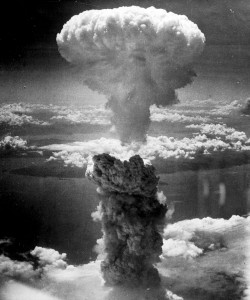 from controlling Europe. “There was, in fact, no other way to defend Western Europe from a Warsaw Pact that by the 1980s boasted more than fifty infantry and armoured divisions, 16 000 tanks, 26 000 fighting vehicles and 4 000 combat aircraft” (Judt, 2010, p.590). Soviet numerical superiority meant that the Warsaw Pact had little to fear from Western conventional forces. Given the longstanding Soviet desire to force NATO out of Berlin we have no reason to think that the Long Peace could have lasted in the absence of a nuclear deterrent.
from controlling Europe. “There was, in fact, no other way to defend Western Europe from a Warsaw Pact that by the 1980s boasted more than fifty infantry and armoured divisions, 16 000 tanks, 26 000 fighting vehicles and 4 000 combat aircraft” (Judt, 2010, p.590). Soviet numerical superiority meant that the Warsaw Pact had little to fear from Western conventional forces. Given the longstanding Soviet desire to force NATO out of Berlin we have no reason to think that the Long Peace could have lasted in the absence of a nuclear deterrent.
Did a moral taboo prevent politicians from using nuclear weapons? Or was the universal horror of the bomb based on rational calculations about the costs of nuclear war? During the Berlin Wall crisis, both General Maxwell Taylor and Assistant Secretary of Defence Paul Nitze proposed that Kennedy fight a rational nuclear war, with limited nuclear strikes against key Soviet bases to bring about a rapid victory. President Kennedy listened to their arguments, but neither he nor Defence Secretary McNamara were convinced that a first strike could achieve total victory, or that a President could keep control of the armed forces in a nuclear exchange (Sabato, 2013, pp. 92-96).
In other words, moral scruples about “The Bomb” did not stop Americas leaders from attacking the USSR; they avoided conflict with Russia because they feared that any exchange of nuclear weapons would quickly spiral out of control. Indeed, fear of Soviet military retaliation in Europe prevented America from using the atom bomb in Korea and Vietnam. The threat of nuclear war even halted wars between small states. Famously, during the Yom Kippur war Israel was prevented from pressing into Syria and Egypt when the Soviets threatened to act unilaterally to defend their allies. Kissinger put the US forces on a global nuclear alert and Nixon pressured the Israelis into accepting a ceasefire (Taylor and Downing, 2008, p.334).
Where does this leave the Long Peace? In Pinker’s own words: “[i]f the Long Peace were a nuclear peace, it would be a fool’s paradise, because an accident, a miscommunication, or an air-force general obsessed with his precious bodily fluids could set off an apocalypse (p.268)”. These scenarios are not as far-fetched as they sound. During the Watergate scandal President Nixon became depressed, emotionally unstable, and began to drink heavily. Secretary of Defence Schlesinger felt compelled to order the head of the Joint Chiefs of Staff to seek his approval before acting on any launch order from the President (Schlosser, 2013, p. 360). The paranoid and elderly Andropov tended to see NATO plots were none existed (ibid, 2013, p.446-448).
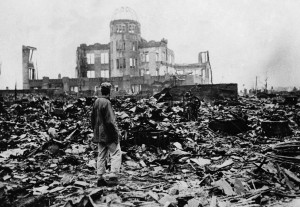 To take one example of the many false alarms which took place during the Cold War: on June 3rd 1980, shortly after the Soviet invasion of Afghanistan, National Security Adviser Zbigniew Brzezinski was awoken to be told that the Soviet Union had launched over 2000 missiles at North America. As bomber crews prepared to invade the USSR and missile crews began to access launch codes, the Pentagon realised that a computer error was responsible, and that no attack was underway (Schlosser, 2013, p. 367-378).
To take one example of the many false alarms which took place during the Cold War: on June 3rd 1980, shortly after the Soviet invasion of Afghanistan, National Security Adviser Zbigniew Brzezinski was awoken to be told that the Soviet Union had launched over 2000 missiles at North America. As bomber crews prepared to invade the USSR and missile crews began to access launch codes, the Pentagon realised that a computer error was responsible, and that no attack was underway (Schlosser, 2013, p. 367-378).
Dramatic retellings of the actions of Kruschev and Kennedy during the Cuban missile crisis create an illusion of control; we assume that politics alone determined the outcome of the crisis. In fact, several events could have precipitated a war accidentally. For example, October 27, 1962, while America was on DEFCON 3, Major Charles Maultsby’s U2 plane got lost collecting air samples above the North Pole. He strayed into Siberian air-space, and Soviet fighters were scrambled to intercept. US fighters, equipped with air-to-air atomic missiles, were sent to protect Maultsby back to safety. Under the rules of engagement, the pilots could fire their atomic weapons at the Soviet fighters under their own authority (Schlosser, 2013, p. 462-463).
As for rational politics, when General George Lee Butler took over as head of the Strategic Air Command in January 1991, just at the end of the Cold War, he decided to review SIOP (Single Integrated Operational Plan, the name given to America’s nuclear war plan from 1960 to 2003). His conclusion?
With the possible exception of the Soviet nuclear war plan, this was the single most absurd and irresponsible document that I had ever reviewed in my life…I came to fully appreciate the truth…we escaped the Cold War without a nuclear holocaust by some combination of skill, luck and divine intervention, and I suspect the latter in greatest proportion” (Schlosser, 2013, p. 457).
Pinker also fails to notice that Europe remained stable during the Long Peace due to the massive ethnic cleansing which took place at the end of the Second World War (Mazower, 1998, 217-224; Snyder, 2011, p.313-338). We should add that if governments have not killed quite so many people during the Long Peace, it is not for want of trying. America, famously, dropped over one million tonnes of explosives on North and South Vietnam; as terrible as the onslaught was, there would have been many more casualties if Vietnam has not been primarily an agricultural society without large urban targets.
In the last half century, we have gone to extraordinary efforts to perfect the art of killing. If only 14% of the civilian and military personnel employed in the US Army are in combat positions, it is because high-tech warfare requires a large support complement to hit its targets both effectively and accurately. Firepower comes at a massive financial cost: the war in Iraq cost America 200 billion dollars in 2003-4 alone (Parker, 2005, p. 429). America’s gargantuan military budget is necessary both to train a “warrior elite” and to develop the technologies which compensate for the West’s numerical inferiority. Can we really claim the world is less violent if nations must go to such lengths to defend themselves?
Conclusion
To repeat, no one is arguing that technological advance and scientific understanding is inherently bad; nobody wants to live without electricity, computers or antibiotics. Rather, the concern is that some myth-makers seem to think that modernity sweeps all problems away before it; that past civilizations have nothing to teach us because they were not technologically advanced; that tradition and faith are always suspect; and that the prejudices of moderns are always correct. Religion and custom are not even critically examined: they are dismissed with a sneer. The problems that have been created by technology and industry are glossed over as concerns for Luddites.
The overall problem with Better Angels is that Pinker refuses to step out of his comfort zone. He can quote historians, but he has not made any attempt to understand their methods. He references popular culture and literature, but does not seem capable of the deep insights that we expect from philosophers and cultural critics. Assertions are backed up with statistics or experimental data but there is rarely a hint that these are open to interpretation. Pinker is forced to twist and turn in his attempt to prove that enlightened government and technological advance is all we need to be happy and wise. It seems a little odd to find so many mistaken claims in a book by a Harvard Professor; but as Father Brown once commented, “you have to know an awful lot to be wrong on so many subjects.”
Bibliography
Asbridge, T. (2010) The Crusades: The War for the Holy Land London: Simon& Schuster
Bell, PMH (2007) The Origins of the Second World War in Europe (Third Edition) London: Pearson Education Limited
Black, J. (2005) The Cold War London: Reaktion Books
Burleigh, M. (2001) The Third Reich: A New History London: Pan Books
Clarke, H. (2011) “Steven Pinker and the An Lushan Revolt” http://bedejournal.blogspot.co.uk/2011/11/steven-pinker-and-an-lushan-revolt.html (retrieved 9th August 2014)
Conway, JS (2003) “Review of Richard Steigmann-Gall. The Holy Reich: Nazi Conceptions of Christianity, 1919-1945” http://www.h-net.org/reviews/showrev.php?id=7658 (retrieved 9th August 2014)
Epstein, R. (2011) “Book Review: The Better Angels of Our Nature” http://www.scientificamerican.com/article/bookreview-steven-pinker-the-better-angels-of-our-nature-why-violence-has-declined/ (retrieved 9th August 2014)
Fergusson, R. (2013) Pinker’s List: Exaggerating Prehistoric War Mortality in Fry D. (ed.) “War, Peace, and Human Nature: The. Convergence of Evolutionary and Cultural Views”, New York: Oxford University Press
Issacs, J. & Downing, T. (2009) Cold War London: Abacus
Judt, T. (2005) Postwar: A History of Europe Since 1945 London: Vintage
Hart, D.B (2012) “The Precious Stephen Pinker” http://www.firstthings.com/article/2012/01/the-precious-steven-pinker (retrieved 9th August 2014)
Kershaw, I. (2009) Hitler London: Penguin
Lerner, C.S. (2012) “Have a Nice Millenium” http://www.claremont.org/article/have-a-nice-millennium/#.U-YSFfldUio (retrieved 9th August 2014)
Madden, T. (2008) Crusades London: Duncan Baird Publishers
Overy, R & Wheatcroft, A (2009) The Road to War: The Origins of World War Two London: Random House
Parker, G. (2005) The Cambridge History of Warfare New York: Cambridge University Press
Pearse, M. (2007) The Gods of War Downers Grove: IVP
Pinker, S. (2011) The Better Angels of Our Nature: The Decline of Violence in History and its Causes London: Allen-Lane
Sabato, R. (2013) The Kennedy Half Century New York: Bloomsbury
Schlosser, E. (2013) Command and Control London: Penguin
Snyder, T. (2011) Bloodlands: Europe Between Hitler and Stalin New York: Basic Books
Tucker, W. (2014) Marriage and Civilization: How Monogamy Made Us Human Washington: Regnery Publishing
Turnbull, R. (2010) Shaftesbury: The Great Reformer Oxford: Lion Books
Tyerman, C. (2004) The Crusades: A Very Short Introduction New York: Oxford University Press
Weale, A. (2010) The SS: A New History London: Abacus
[i] Although he does draw some attention to its importance in the United States (p.106-108); and elsewhere (p.687). Tucker (2014) stresses the importance of faithful, monogamous families for civil virtue, although at times he is guilty of overstating his case.
[ii] See Humphrey Clarke’s analysis: http://bedejournal.blogspot.co.uk/2011/11/steven-pinker-and-an-lushan-revolt.html
James Hannam’s review is kinder, but he is also disappointed by the “large number of errors” in the text: http://bedejournal.blogspot.co.uk/2013/12/steven-pinkers-better-angels-of-our.html
[iii] As if the debate between functionalists and intentionalists never took place in the study of the Holocaust!




